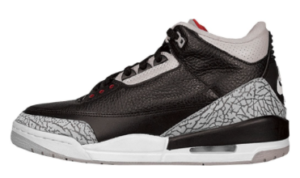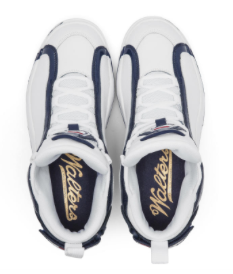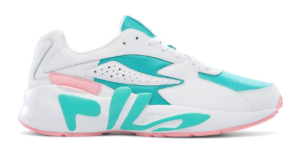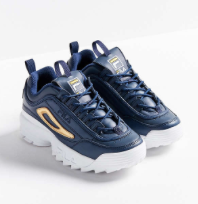
Sneakers have been a fascination of popular culture for decades, from the enigmatic Adidas Superstar and the Louis Vuitton x Kanye West Don, the humble Chuck Taylor to the infamous Rick Owen’s Runner. Many debate the exact point sneakers left mundane necessity and entered the ranks of lifestyle and status goods, but there is no denying their market reach or clout.
The sneaker market has changed significantly as interest has grown and its history deepened. In 2017, Nike, Adidas and Puma, the three largest brands in the industry, grossed a collective 33 billion dollars. Sneakers entered the venue of major fashion slowly, the first luxury sport shoe being the Gucci Tennis releasing in 1984, one year before the Air Jordan I. Sneakers now sell for thousands, with the names of prominent celebrities or the logos of luxury brands attached.
As sneakers changed from fitness to fashion, brands began using exclusivity as marketing. Patrick Morrison saw this firsthand, at Walter’s Clothing. Morrison does stocking and PR for Walter’s Clothing, a mainstay sneaker and sportswear store of downtown Atlanta. Morrison saw the business change, with the big producers limiting distribution of the most hyped products to select retailers. A limited number of stores in an area got a limited number of shoes.
“Certain stores will get only so many pairs and they won’t be everywhere,” Morrison said. “That’s what makes the shoe hot.”
Morrison marks the market shift to a single year: 1988, the year Michael Jordan won the scoring title and the NBA dunk contest, and received Defensive Player of the Year honors and the MVP award. He was the first player in the league to hold all of them at once. That was also the year Nike released the Air Jordan III. The Air Jordan III was the first shoe designed by Tinker Hatfield, who would become synonymous with the brand, going on to design the III through the XV, and coming back to design the XX. The shoe’s design was a radical departure from its predecessors with a mid-top cut, visible Nike Air in the heel, elephant print and a new “Jumpman” logo.

Soon, a new pair of commercials accompanied the shoe, directed by and starring Spike Lee under the pseudonymic character “Mars Blackmon” from Lee’s 1996 film “She’s Gotta Have It”. Spike Lee would also go on to become a mainstay of the Jordan mythology. Morrison believes this event to have ushered in the era of celebrity fascination with sports lifestyle products like sneakers.
“The marketing whole scheme changed in 88’ when Spike Lee and Michael Jordan did a commercial,” Morrison said.
But according to Morrison, it wasn’t until 1997, after the split of Jordan Brand from Nike, that supply and distribution was intentionally limited. The new brand released the Air Jordan XIII and the first markdown “team” models as well as gym trainers. After the split, they wanted to be more selective and strategic in how they were releasing merchandise.
“They hired two seperate reps for [Nike and Jordan],” Morrison said. “That’s when they started allocation to the rep, they’d only give him so many pairs.”
But, once retailers gain the trust of a brand representative, the allocation of product doesn’t come without caveats. Often, retailers looking to stock their shelves with hot gear are required to buy a brand’s whole line, or no deal.
“In order to buy those from [Jordan Brand], you also have to buy their other shoes.” Morrison said. “They want you to buy all the apparel that comes with the retros too.”
Retros, re-released models of decades-old shoes, never seem to fail to generate interest at Walter’s. Specifically retro Jordans, models I through XV, the models Michael Jordan himself played in. But the trend isn’t limited to Jordans, Morrison admits.
“Everything is a retro now,” Morrison said.
He has his own theories as to why. Attributing the mainstreaming of sneaker culture to the success of Jordan Brand, he says people who watched Jordan play are the ones driving the market now.
“If it’s 1985 and you’re a teenager, you’re almost 50 years old now,” Morrison said. “Sneaker culture has been around that long.”
The interest in retro shoes and the growth of online markets like GOAT, StockX and Flight Club have created interesting competition for brick and mortar retailers like Walter’s. Thriving off the insecurity and anxiety of eBay, where sneaker reselling began online, these companies are able to authenticate their inventory before listing it. There’s an ironic contrast, that old shoes could fuel a new market.
Stores like Walter’s have one advantage, though. Online stores create no relationship with consumers or suppliers. And though they can sell anything they get their hands on, it’s always other brands products, never their own.
Relationships are important to Morrison, who said Walter’s has been a landmark of downtown Atlanta long enough to make more than a few. Walter’s has a special relationship with the brand Fila, with whom Walter’s has frequent dialogue.
“We got a great relationship with them,” Morrison said. “We told them some things to do and they did it and they saw business pick up.”
He says Fila gained notoriety at Walter’s when their price rose over $100, which at the time was far out of the norm. For context, the first pair of shoes Morrison bought on his own were canvas Nike Bruins for $14.95. Fila broke that norm selling luxury Italian leather and craftsmanship to the American street market, a move the Air Jordan 2’s would later adopt. And through business at Walter’s, they’ve made a comeback.
Morrison said Walter’s has always stocked Fila, to the point the Italian brand would gain recognition as an Atlanta item. The brand enjoys a place on the feet of Georgia State’s trend-savvy students, as well as many longtime Atlanta residents, earning a generous shoutout in F.I.L.A. (Forever I Love Atlanta), the 2004 crunk piece by Lil Scrappy.
“We sold Fila so well, Urban Outfitters came to Fila,” Morrison said. “We kinda set the trend on certain things because we’ve been here so long.”
What was the advice Walter’s gave to Fila?
“More colors,” Morrison said. “And a specific shoe that we wanted.” He gestured to the Fila Fitness trainer on the wall. “We told them we wanted to do it as a mid top […] now it’s in their line but we had the first rights for it for a while.”
Walter’s was also able to collaborate on an exclusive retro colorway of the Fila Grant Hill 96, formerly the Grant Hill 2. The shoe features the branding of the Atlanta retailer printed on the insole.

“We got Fila to make the shoe for us, we bought over 300 pairs and sold them all,” Morrison said.
Fila is no stranger to collaborations with retailers or designers. Most recently, they collaborated with fashion photographer Julien Boudet of Bleu Mode on the zippered, Brooklyn-esque Fila Fitness. More notably, in April 2018, they released a package retroing the Mindblower silhouette and introducing the Mindblower 2.0, collaborating with 47 designers and boutiques.

Even Urban Outfitters, late to the Fila trend by Morrison’s standards, got a collab. The Disruptor II, mentioned as being Fila’s answer to the luxury “dad shoes” of the Balenciaga Triple S’ and Raf Simons Ozweegos, was dressed down in navy blue and khaki for the brand.

